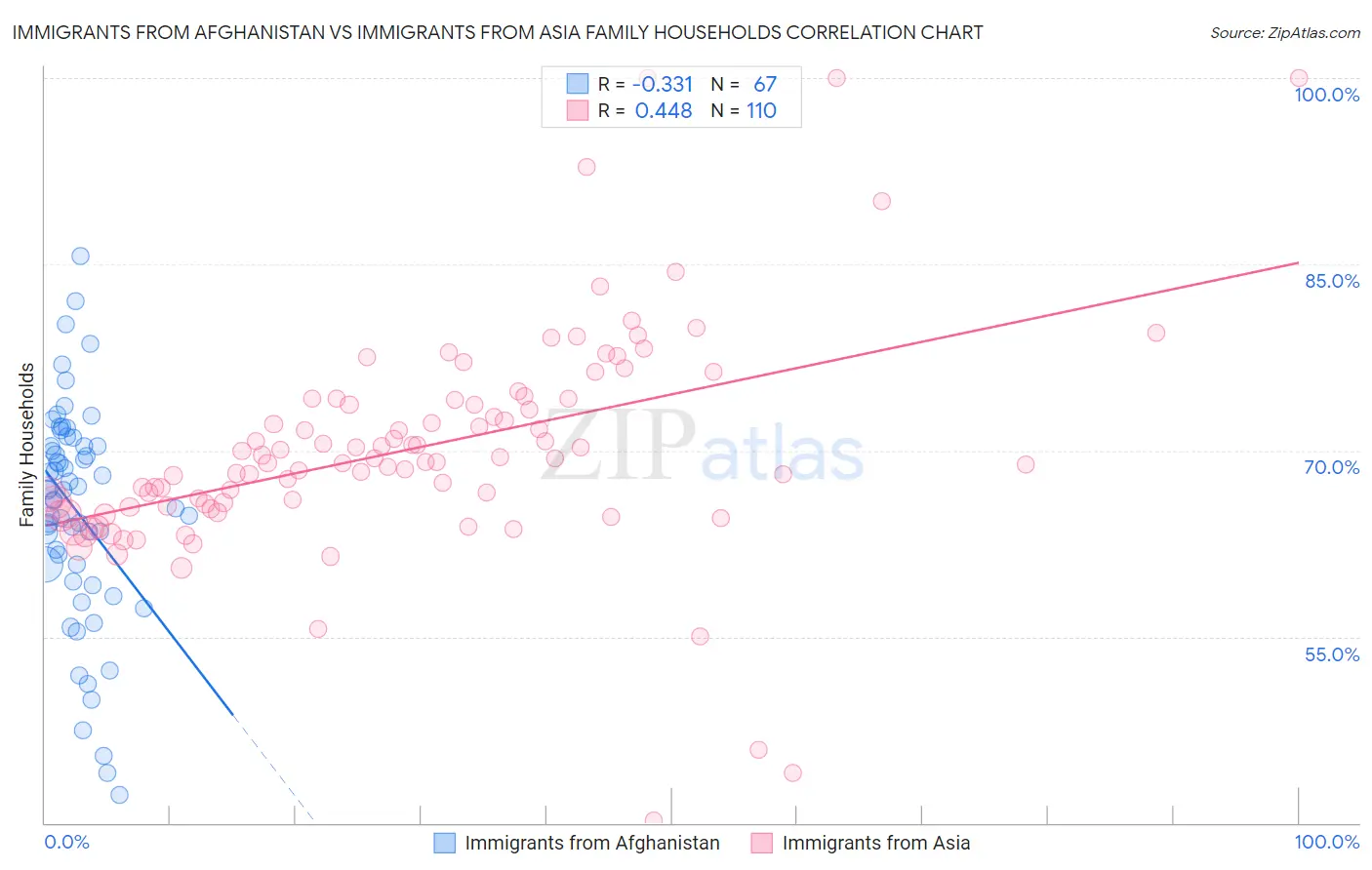Immigrants from Afghanistan vs Immigrants from Asia Family Households
COMPARE
Immigrants from Afghanistan
Immigrants from Asia
Family Households
Family Households Comparison
Immigrants from Afghanistan
Immigrants from Asia
65.9%
FAMILY HOUSEHOLDS
99.9/ 100
METRIC RATING
70th/ 347
METRIC RANK
66.1%
FAMILY HOUSEHOLDS
100.0/ 100
METRIC RATING
58th/ 347
METRIC RANK
Immigrants from Afghanistan vs Immigrants from Asia Family Households Correlation Chart
The statistical analysis conducted on geographies consisting of 147,637,809 people shows a mild negative correlation between the proportion of Immigrants from Afghanistan and percentage of family households in the United States with a correlation coefficient (R) of -0.331 and weighted average of 65.9%. Similarly, the statistical analysis conducted on geographies consisting of 548,543,678 people shows a moderate positive correlation between the proportion of Immigrants from Asia and percentage of family households in the United States with a correlation coefficient (R) of 0.448 and weighted average of 66.1%, a difference of 0.29%.

Family Households Correlation Summary
| Measurement | Immigrants from Afghanistan | Immigrants from Asia |
| Minimum | 42.3% | 40.2% |
| Maximum | 85.6% | 100.0% |
| Range | 43.4% | 59.8% |
| Mean | 65.1% | 70.1% |
| Median | 66.8% | 69.0% |
| Interquartile 25% (IQ1) | 60.8% | 65.5% |
| Interquartile 75% (IQ3) | 70.4% | 74.1% |
| Interquartile Range (IQR) | 9.6% | 8.6% |
| Standard Deviation (Sample) | 8.8% | 9.1% |
| Standard Deviation (Population) | 8.7% | 9.1% |
Demographics Similar to Immigrants from Afghanistan and Immigrants from Asia by Family Households
In terms of family households, the demographic groups most similar to Immigrants from Afghanistan are Malaysian (65.9%, a difference of 0.010%), Bhutanese (65.9%, a difference of 0.020%), Japanese (65.9%, a difference of 0.040%), Fijian (65.9%, a difference of 0.060%), and Filipino (65.9%, a difference of 0.060%). Similarly, the demographic groups most similar to Immigrants from Asia are Immigrants from Korea (66.0%, a difference of 0.020%), South American (66.0%, a difference of 0.030%), Danish (66.0%, a difference of 0.050%), Central American (66.0%, a difference of 0.080%), and Pennsylvania German (66.1%, a difference of 0.11%).
| Demographics | Rating | Rank | Family Households |
| Immigrants | Colombia | 100.0 /100 | #54 | Exceptional 66.3% |
| Immigrants | Immigrants | 100.0 /100 | #55 | Exceptional 66.1% |
| Immigrants | Hong Kong | 100.0 /100 | #56 | Exceptional 66.1% |
| Pennsylvania Germans | 100.0 /100 | #57 | Exceptional 66.1% |
| Immigrants | Asia | 100.0 /100 | #58 | Exceptional 66.1% |
| Immigrants | Korea | 100.0 /100 | #59 | Exceptional 66.0% |
| South Americans | 100.0 /100 | #60 | Exceptional 66.0% |
| Danes | 100.0 /100 | #61 | Exceptional 66.0% |
| Central Americans | 100.0 /100 | #62 | Exceptional 66.0% |
| Immigrants | Indonesia | 100.0 /100 | #63 | Exceptional 66.0% |
| Pima | 99.9 /100 | #64 | Exceptional 65.9% |
| Costa Ricans | 99.9 /100 | #65 | Exceptional 65.9% |
| Fijians | 99.9 /100 | #66 | Exceptional 65.9% |
| Filipinos | 99.9 /100 | #67 | Exceptional 65.9% |
| Japanese | 99.9 /100 | #68 | Exceptional 65.9% |
| Malaysians | 99.9 /100 | #69 | Exceptional 65.9% |
| Immigrants | Afghanistan | 99.9 /100 | #70 | Exceptional 65.9% |
| Bhutanese | 99.9 /100 | #71 | Exceptional 65.9% |
| Portuguese | 99.9 /100 | #72 | Exceptional 65.8% |
| Laotians | 99.9 /100 | #73 | Exceptional 65.8% |
| Burmese | 99.9 /100 | #74 | Exceptional 65.7% |